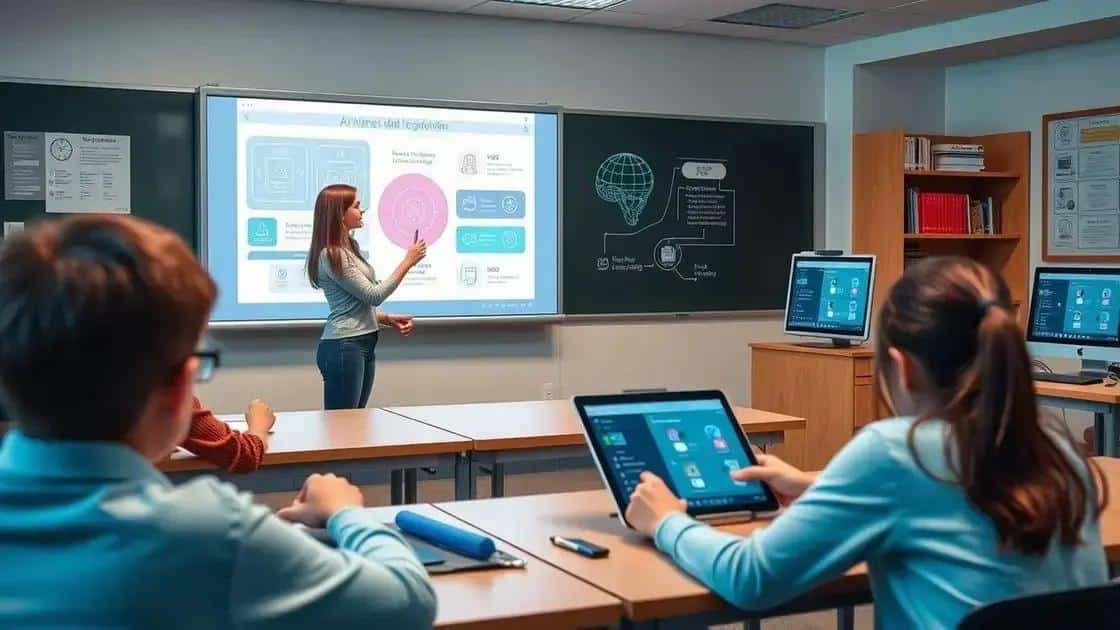Some ai in the classroom: how technology transforms education

The integration of AI in education enhances personalized learning, automates administrative tasks, and fosters collaboration, while also addressing challenges such as data privacy and equitable access to technology.
Some ai in the classroom is changing how we approach education today. Have you ever wondered how technology makes learning more engaging and effective? Let’s explore what AI brings to the table.
Understanding AI in education
When we talk about AI in education, we refer to the ways artificial intelligence is enhancing how teachers and students interact. This technology is bringing exciting changes to the classroom environment.
What is AI?
AI stands for artificial intelligence, which involves machines that can learn and make decisions. In education, this means using technology that can adapt to students’ needs. Imagine a class where each student has a tool that understands their learning pace!
Benefits of AI in Education
There are many advantages when we integrate AI in school settings. These benefits include:
- Personalized learning experiences
- Efficient administrative tasks for teachers
- Immediate feedback for students
- Access to a wealth of resources
With AI, students can receive help tailored specifically to them. For example, if a student struggles with math, AI can offer extra practice problems and explanations, helping them improve at their own pace.
Furthermore, educators can save time on repetitive tasks because AI systems can handle grading and organizing class materials. This allows teachers to focus more on engaging with their students.
Examples of AI Tools in Education
Some common AI tools used in classrooms today include chatbots that assist with answering student queries, adaptive learning software that personalizes content, and programs that analyze data to improve teaching strategies.
These innovations are just the beginning! As AI technology evolves, we can expect even more advanced tools to emerge, shaping how we teach and learn.
Benefits of integrating AI in classrooms
Integrating AI in classrooms offers numerous benefits that can greatly enhance the educational experience. These technologies empower both students and teachers, making learning more effective and efficient.
Personalized Learning
One of the standout benefits of AI is its ability to create personalized learning experiences. Each student learns differently, and AI can adjust lessons to fit individual needs. It can analyze a student’s performance and suggest tailored resources, exercises, or feedback that suit their specific learning style.
Increased Engagement
AI tools can boost student engagement by creating interactive and immersive learning experiences. Gamified learning platforms utilize AI to adapt challenges based on student progress, making education both fun and informative. Furthermore, students are more likely to stay focused and motivated when they can interact with technology.
- Interactive Simulations
- Real-time Assessment
- AI-driven tutoring systems
- Customized study plans
Another advantage is the immediate feedback students receive. With AI-powered systems, learners can understand their mistakes right away, allowing them to correct themselves and grasp concepts better. This timely response can significantly improve learning outcomes.
Efficiency for Teachers
Teachers also benefit from integrating AI. It can handle routine tasks like grading assignments and tracking student progress, which saves valuable time. With AI managing these administrative tasks, educators can devote more time to teaching and connecting with their students. AI can even help in developing lesson plans based on curriculum standards and classroom needs.
As educators begin to adopt AI, classrooms will evolve into more dynamic and interactive environments. These advancements can lead to improved educational outcomes and prepare students for a technology-driven world.
Common AI tools for teachers

Many AI tools for teachers are now available, making classroom management more efficient and enhancing the learning experience for students. These tools help educators streamline their tasks and foster a more interactive environment.
Learning Management Systems (LMS)
One significant category of AI tools is Learning Management Systems. These platforms allow teachers to create digital classrooms where they can post assignments, track student progress, and provide resources.
Grading and Assessment Tools
Grading can be a time-consuming task. AI grading tools can quickly and accurately assess student work, saving teachers considerable time. This allows them to focus more on lesson planning and student engagement.
- Automated essay scoring systems
- Online quiz and test grading software
- Performance analytics platforms
- Feedback generation tools
Another remarkable feature of these tools is their ability to provide instant feedback to students. Learning can be improved when students receive guidance on their strengths and areas for improvement right away.
Adaptive Learning Technologies
Adaptive learning systems use AI to adjust the learning path based on individual student performance. These systems analyze data to understand what each student needs to focus on, offering personalized content that keeps them engaged and learning effectively.
For example, if a student struggles with a math concept, the tool can provide additional practice and resources specifically targeting that area, making learning more effective.
Virtual Assistants
Virtual assistants are also becoming popular in classrooms. These AI-driven tools can answer student questions, help with scheduling, and assist teachers in organizing their day. They can free up valuable time and help maintain order in the classroom.
As teachers embrace these AI tools, they not only improve their own efficiency but also create a rich learning environment for all students. With continuous advancements in technology, the role of AI in education is expected to expand even further.
Challenges of using AI in education
While AI in education presents many benefits, there are also challenges that educators face when implementing these technologies. Addressing these issues is crucial for successful integration into classrooms.
Data Privacy Concerns
One major challenge is the concern over data privacy. As AI systems collect information about students, there is a risk of sensitive data being exposed or misused. Schools must ensure they have strong protections in place to keep this data secure.
Equity in Access
Another challenge is equity. Not all students have equal access to the technology needed to benefit from AI tools. This disparity can create a divide between students who have resources and those who do not, potentially widening the achievement gap.
- Technology in low-income schools
- Home access to the internet
- Training educators on new tools
- Financial constraints for schools
Furthermore, effectively training teachers to use these AI tools can be a hurdle. Educators may need additional support and resources to feel comfortable incorporating these technologies into their teaching strategies. Without proper training, the potential of AI may not be fully realized.
Over-reliance on Technology
There’s also the risk of over-reliance on technology. While AI can enhance teaching, it should not replace genuine interactions between teachers and students. Maintaining a balance is essential for effective learning.
Lastly, as AI continues to evolve, educators face the challenge of keeping up with rapid changes and updates. This constant evolution can lead to difficulties in staying current with the latest advancements and best practices.
By understanding these challenges, schools can develop strategies to effectively integrate AI in education, ensuring that all students benefit from technological advancements.
Future of AI in learning environments
The future of AI in learning environments holds exciting possibilities that can transform how education is delivered. As technology advances, schools are beginning to incorporate AI to improve teaching and learning experiences.
Enhanced Personalization
One major trend is enhanced personalization in education. Future AI systems will be able to analyze student data more effectively to create individualized learning plans. This means that every student can have a unique educational path based on their strengths and weaknesses, maximizing their learning potential.
Virtual Classrooms
The rise of virtual classrooms is another significant development. With improved connectivity and AI technology, students could attend classes from anywhere in the world. This can provide access to education for those in remote areas, ensuring everyone has the opportunity to learn.
- Global collaboration among students
- Access to diverse resources
- Flexible learning schedules
- Technology-enabled engagement methods
Moreover, AI will facilitate real-time collaboration among students globally. They can work together on projects, share resources, and learn from one another’s perspectives, making learning a more rich and dynamic experience.
Automation of Administrative Tasks
In the future, schools can expect a significant reduction in the time spent on administrative tasks due to AI automation. This will allow teachers to focus more on pedagogy and less on paperwork. With AI handling grading, attendance, and scheduling, educators can dedicate more time to individualized student support.
Additionally, AI’s predictive analytics will help educators identify at-risk students earlier, enabling timely interventions. This proactive approach can lead to better student outcomes, as support can be tailored to their specific needs.
Continuous Learning and Development
As AI technologies evolve, ongoing training programs for educators will be essential. Teachers will need continuous support to adapt to new tools and methodologies. This will ensure that they can fully harness the potential of AI in learning environments.
The integration of AI in education promises vast improvements. With ongoing advancements, the educational landscape will become more interactive, inclusive, and effective, ultimately preparing students for the future.
FAQ – Frequently Asked Questions about AI in Learning Environments
What are the main benefits of using AI in the classroom?
AI offers personalized learning experiences, increases student engagement, and helps automate administrative tasks for teachers.
How can AI tools support teachers?
AI tools assist teachers by automating grading, providing insights into student performance, and helping create customized lesson plans.
What challenges might schools face when implementing AI?
Schools may encounter data privacy issues, equity in access to technology, and the need for teacher training to effectively use AI tools.
How does AI enhance collaboration among students?
AI facilitates real-time collaboration, allowing students to work together on projects from different locations and share ideas easily.





